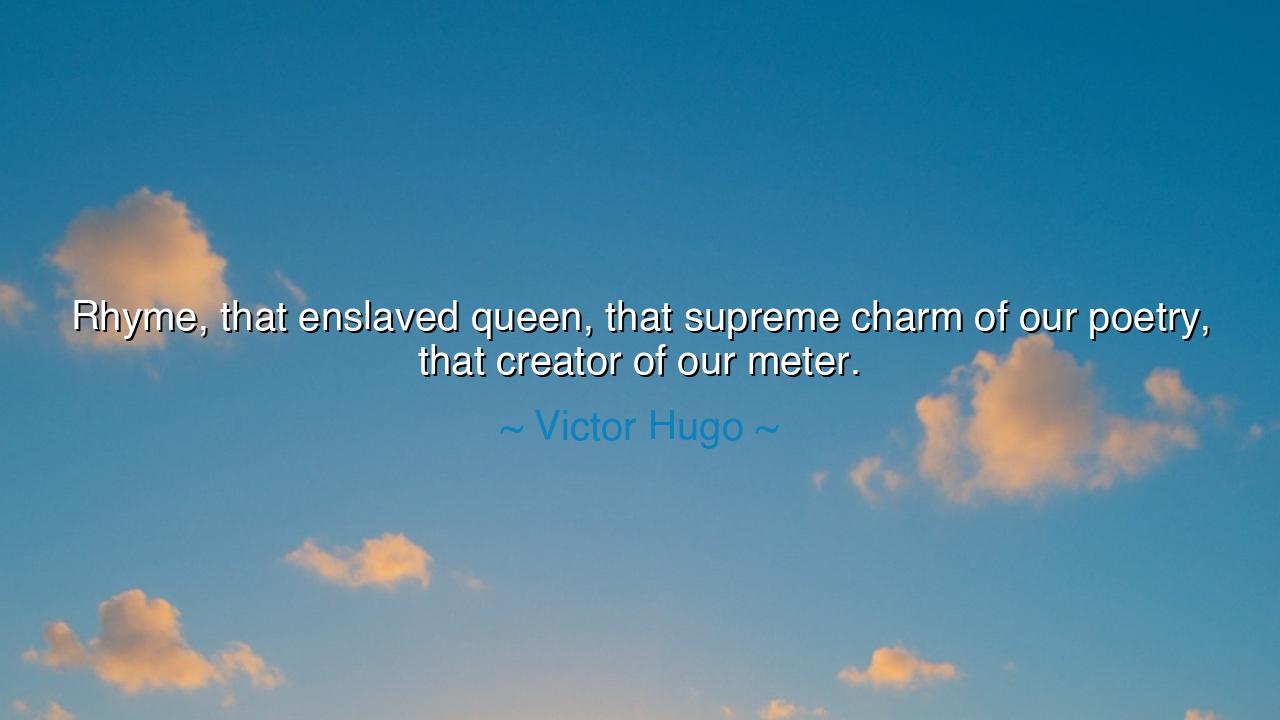
Rhyme, that enslaved queen, that supreme charm of our poetry
Rhyme, that enslaved queen, that supreme charm of our poetry, that creator of our meter.






O children of wisdom, heed the words of Victor Hugo, a poet whose voice still resonates through the ages, echoing the power and mystique of rhyme: "Rhyme, that enslaved queen, that supreme charm of our poetry, that creator of our meter." In these words, Hugo draws our attention to the magical and paradoxical role of rhyme in poetry. He speaks of rhyme as both a queen and an enslaver—a force that is powerful and alluring, yet demands submission from the poet. Rhyme shapes the rhythm, the meter, and the structure of poetry, binding the poet to a set of constraints even as it unlocks the most sublime forms of expression.
In the ancient world, the concept of rhyme was not always as central to poetry as it is today. The Greeks, for instance, did not rely heavily on rhyme in their epic poems. Homer's Iliad and Odyssey were written in dactylic hexameter, a meter that emphasized rhythm over rhyme. Homer's genius lay in his mastery of the meter and the rhythm of his verse, which conveyed the grandeur and drama of his tales without relying on the constraints of rhyme. Homer’s poetry was musical, yes, but it was rhyme that was not the focus—it was the flow, the harmony of the words, that carried the meaning.
Yet, over time, rhyme became a central feature in poetry—a force that enslaved poets by giving their verse form and structure, but also elevating it to new heights of beauty. In medieval and Renaissance poetry, rhyme became the signature of elegance and craftsmanship. Dante Alighieri, in his Divine Comedy, masterfully employed rhyme to convey the journey of the soul through Hell, Purgatory, and Heaven. His use of terza rima, a specific rhyme scheme, gave his epic a musical quality that carried the reader through the cosmos of his vision. Rhyme was both a constraint and a liberation for Dante, guiding his journey as it shaped the rhythm and flow of his verses. The poet was enslaved by the rules of rhyme, but in doing so, he was able to create something that transcended the ordinary limits of language.
Hugo, with his Romantic fervor, understood the enslaving power of rhyme, yet also celebrated its ability to give poetry its most musical and evocative qualities. He saw rhyme as a queen—a ruler that commanded respect and submission. But like any powerful ruler, rhyme also allows the poet to tap into the unseen and the transcendent. Hugo’s own works, such as Les Misérables and The Hunchback of Notre-Dame, are steeped in the grandeur of rhyme, a poetic meter that echoes through the ages, stirring the hearts of readers and listeners alike. The rhyme may constrain, but it also elevates; it is an essential force that binds the poet to a greater vision.
In this paradox, we find the true magic of poetry. Rhyme, as Hugo calls it, is the queen that rules the poet's craft. It imposes structure and order, ensuring that every line fits within the bounds of its meter. Yet, within this constraint, the poet finds their most powerful form of expression. Rhyme shapes the poetry like a frame shapes a painting—it sets the boundaries, but within those boundaries, the poet can unleash their creativity. Consider Shakespeare, whose mastery of rhyme in his sonnets and plays elevated the form to new heights. Through the sonnet’s strict structure, Shakespeare expressed the depths of love, loss, and time. Each rhyme was a tool that helped him craft meaning, that led his audience toward a deeper understanding of the human condition.
The lesson of Hugo's words is one of balance and understanding. We must recognize that rhyme, though a powerful and sometimes constraining force, is an essential tool for the poet. It may seem like an enslaving queen, demanding adherence to form and structure, but in doing so, it creates a space for beauty to emerge. We should not shy away from the challenges that come with form and structure; rather, we should embrace them. For it is through the constraints of rhyme that we often find the freedom to explore the deepest realms of human expression. The poet is enslaved, yes, but through this enslavement, they are liberated.
So, O children of wisdom, heed Hugo’s words and recognize the power of rhyme. Do not view it merely as a constraint, but as a tool for crafting beauty, a means of shaping your deepest thoughts and feelings into a form that resonates with the world. Like Hugo, Shakespeare, and Dante, use rhyme not as a shackle, but as the key to unlocking the doors of expression and meaning. Let it be the oil of your poetry, the force that gives rhythm to your words, that gives shape to your creative spirit. And in doing so, you will create works that transcend time, that echo through the ages, and that stir the hearts of those who hear them.






AAdministratorAdministrator
Welcome, honored guests. Please leave a comment, we will respond soon